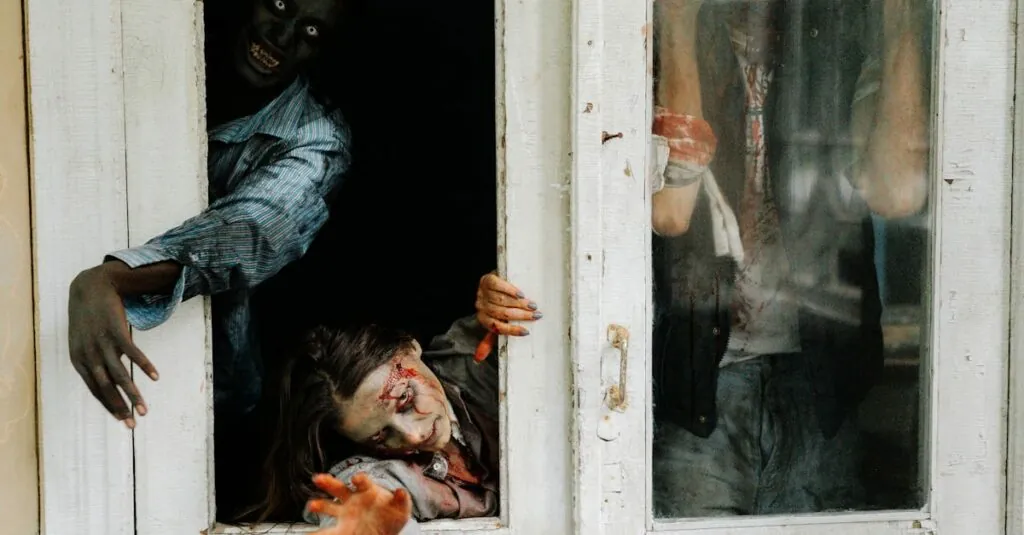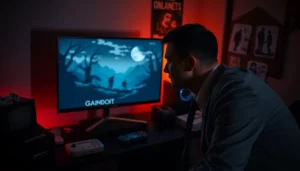Table of Contents
ToggleIn a world where nightmares lurk just beyond the shadows, survival horror stands as the ultimate test of courage and wits. This genre doesn’t just aim to scare; it challenges players to confront their deepest fears while navigating through spine-chilling environments. From eerie soundtracks to grotesque creatures, survival horror immerses players in a gripping experience that keeps them on the edge of their seats.
Imagine being chased by a relentless monster while your flashlight flickers like a dying firefly. That’s the thrill of survival horror—it’s a rollercoaster ride of suspense and adrenaline that leaves even the bravest souls questioning their sanity. Whether it’s a haunted mansion or a post-apocalyptic wasteland, these games push players to their limits, making every decision a matter of life or death. Buckle up; the world of survival horror is waiting to test just how far you’re willing to go to survive.
The Origins Of Survival Horror
Survival horror emerged as a distinct genre shaped by various influences and market demands. Its roots trace back to early video games that incorporated elements of fear and suspense.
Early Influences
Several classic horror films and literature inspired the genre’s development. German Expressionist cinema, like “Nosferatu,” introduced dark visuals and unsettling atmospheres. Additionally, novels such as Mary Shelley’s “Frankenstein” and Bram Stoker’s “Dracula” explored themes of mortality and the supernatural, influencing narrative styles. These influences set the stage for immersive storytelling and intense emotional responses in players.
Pioneering Games
Key titles in the 1990s helped define survival horror gameplay mechanics. “Resident Evil,” released in 1996, combined resource management with intense encounters against horrific creatures. Following this, “Silent Hill” introduced psychological elements that emphasized fear through atmosphere rather than solely through monsters. Other notable games, like “Alone in the Dark,” contributed to the foundational elements of exploration, puzzle-solving, and combat, paving the way for the genre’s evolution. These pioneering games highlighted the intricate balance between survival, horror, and player agency.
Key Elements Of Survival Horror
Survival horror games involve several critical elements that enhance the player’s experience. Each component contributes uniquely to the immersive atmosphere.
Atmosphere And Setting
Atmosphere plays a vital role in survival horror. Dark, unsettling environments create tension and unease. Settings like abandoned mansions or desolate streets amplify fear. Lighting design often incorporates shadows and dim lighting, leaving players uncertain of what lurks nearby. Environmental storytelling deepens immersion, with hidden clues revealing the history behind locations. Sound design complements the visuals, using ambient noises to heighten anticipation. Players often experience heightened anxiety as they navigate through eerie landscapes, making every corner a potential threat.
Gameplay Mechanics
Gameplay mechanics define how players survive terrifying challenges. Limited resources force players to manage ammunition and health carefully. Exploration becomes essential; scavenging for supplies enhances the survival aspect. Puzzle-solving integrates seamlessly, encouraging critical thinking under pressure. Fear of confrontation drives strategic avoidance of enemies, increasing suspense. Save systems often include checkpoints or limited saves, adding to the tension. Engaging gameplay mechanics not only challenge players but also keep them engaged in the game’s harrowing atmosphere.
Narrative Design
Narrative design propels the survival horror experience forward. Compelling stories often revolve around themes of isolation and despair. Characters are typically placed in dire situations, evoking empathy from players. Plot twists and psychological elements contribute to an unpredictable narrative. Narratives often reveal dark secrets through dialogue and environmental clues, pulling players deeper into the story. Characters’ choices frequently impact outcomes, reinforcing player agency. Ultimately, powerful storytelling immerses players in the unfolding horror, transforming their journey into a personal survival experience.
Iconic Survival Horror Games
Survival horror games have defined the genre with their gripping narratives and chilling atmospheres. They stand out for their unique ability to engage players in terrifying scenarios.
Resident Evil Series
The Resident Evil series revolutionized survival horror with its debut in 1996. Players explore haunted mansions filled with zombies and terrifying creatures. Gameplay emphasizes resource management and puzzle-solving. Iconic titles like Resident Evil 2 and Resident Evil 7 introduce immersive mechanics and deep storytelling. This series maintains a complex narrative, often exploring viral outbreaks and survival against overwhelming odds. Players find themselves navigating treacherous environments with limited ammunition and health, heightening suspense.
Silent Hill Series
The Silent Hill series delves into psychological horror, immersing players in nightmarish landscapes. Introduced in 1999, it focuses on themes of guilt and trauma. Intricate narratives unfold through emotionally charged characters and surreal settings. Games such as Silent Hill 2 are renowned for their haunting atmosphere and chilling sound design. Players confront their fears as they navigate foggy streets and abandoned buildings. Each title in this series emphasizes psychological elements, showcasing a blend of horror that lingers long after gameplay ends.
Other Notable Titles
Numerous other titles contribute significantly to the survival horror genre. Dead Space, released in 2008, combines sci-fi elements with visceral horror, challenging players aboard a derelict spacecraft. Amnesia: The Dark Descent, launched in 2010, immerses players in an eerie environment while focusing on psychological fear rather than combat. Outlast, known for its first-person perspective, forces players to hide and run without weapons. Each of these games showcases different aspects of horror, expanding the genre beyond its foundational titles and adding depth to player experiences.
The Evolution Of Survival Horror
Survival horror continuously evolves, driven by cultural influences, technological advancements, and shifting player expectations.
Technological Advancements
Graphics innovations have profoundly transformed survival horror’s visual storytelling. For instance, the transition from 8-bit graphics to photorealistic environments heightened immersion. Developers leverage advanced rendering techniques to create eerie atmospheres, enhancing player tension. Sound design also experienced considerable improvements, shifting from simple effects to complex audio landscapes that intensify fear. Virtual reality technology introduced an unprecedented level of engagement, as players become physically part of the horror experience. Controllers now offer haptic feedback, allowing players to feel vital in-game moments. Overall, these advancements contribute to a more visceral interaction with the genre.
Changing Player Expectations
Player expectations within survival horror have shifted significantly over time. Modern audiences seek intricate narratives that challenge their emotions and psychological states. Gamers demand rich world-building, character depth, and ethical dilemmas that go beyond traditional scares. They increasingly value replayability and branching storylines, often desiring multiple endings. Community discussions amplify expectations, as players share horror experiences and insights across social platforms. Expedient access to updates and additional content keeps engagement high while pushing developers to innovate continually. Ultimately, these evolving expectations shape the production of future survival horror titles, making the genre dynamic and responsive to its audience.
The Future Of Survival Horror
Survival horror continues to evolve, reflecting changes in technology and player preferences. The genre faces exciting possibilities for advancement.
Emerging Trends
Immersive storytelling now captures players’ attention, emphasizing emotional depth and psychological horror. Developers focus on creating complex narratives that explore themes of trauma and morality. Games increasingly incorporate social commentary, addressing real-world issues and fears. Additionally, community-driven experiences engage players, fostering a sense of shared journey. As streaming platforms grow, content creators influence how audiences perceive and engage with survival horror, creating demand for more interactive content. Multiplayer modes are also gaining traction, allowing collaborative gameplay while maintaining the genre’s suspenseful atmosphere.
Potential Innovations
Technological advancements promise to redefine survival horror. Virtual reality experiences immerse players wholly, allowing them to confront fears in an interactive environment. Haptic feedback devices enhance sensations, making players feel the tension and urgency more profoundly. Procedural generation offers limitless environments, ensuring replayability and unpredictability. The integration of AI can create dynamic enemy behaviors, adapting to player strategies for a unique, personalized challenge. In addition, augmented reality applications may blend real-world elements with game mechanics, transforming everyday spaces into chilling landscapes. Overall, the future holds significant potential for survival horror, inviting innovations that enhance player engagement.
Survival horror continues to captivate players with its unique blend of fear and strategy. As the genre evolves it embraces new technologies and storytelling techniques that deepen emotional engagement. The shift towards immersive experiences and complex narratives reflects players’ desires for more than just scares; they want meaningful journeys that challenge their perceptions and emotions.
With the rise of virtual reality and innovative gameplay mechanics the future of survival horror looks promising. Developers are poised to push boundaries and create experiences that not only thrill but also resonate on a personal level. As this genre adapts to changing landscapes it will undoubtedly continue to draw in new audiences while satisfying long-time fans.







